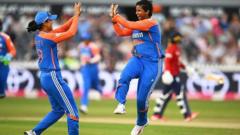Is England's T20 Struggles Against India a Cause for Concern?

India's Dominance in T20 Cricket: A Deep Dive into the Second T20 at Bristol
The second T20 match between India and England at Bristol showcased a compelling display of cricketing prowess, with India taking a commanding 2-0 lead in the five-match series. The match was marked by standout performances, strategic gameplay, and a further exploration of England’s batting frailties. This article delves into the key aspects of the game, analyzing player performances, strategies employed, and the implications for both teams moving forward.
The Match Overview
India posted a strong total of 181-4 in their allotted 20 overs, with Amanjot Kaur and Jemimah Rodrigues contributing significantly with their respective scores of 63 runs. England, in response, struggled to maintain momentum, ultimately finishing at 157-7, resulting in a 24-run victory for India. The match not only highlighted India's strengths but also exposed England's weaknesses, particularly in the batting department.
First Innings: India’s Strong Recovery
India’s innings began on a shaky note as they lost three wickets within the powerplay, reaching a low of 31-3. The fall of star player Smriti Mandhana for just 13 runs was a significant blow. However, the partnership between Kaur and Rodrigues was crucial for India’s recovery. Here’s a breakdown of their innings:
- Amanjot Kaur: Scored 63 runs off 40 balls, showcasing a mix of aggressive and strategic batting.
- Jemimah Rodrigues: Equally impressive with 63 runs off 41 balls, she played a crucial role in stabilizing the innings.
- Richa Ghosh: Contributed an unbeaten 32 runs, ensuring a strong finish to the innings.
The turning point came during the fourth-wicket partnership, where Kaur and Rodrigues added 93 runs, demonstrating excellent running between the wickets and punishing loose deliveries. Their ability to rotate the strike effectively kept the pressure on the English bowlers.
Bowling Performance by England
Despite the early breakthroughs, England struggled to maintain control during the middle overs. Lauren Bell emerged as a standout bowler with impressive figures of 2-17, including the key wickets of Mandhana and Rodrigues. However, the rest of the bowling attack struggled to contain the Indian batsmen, especially in the death overs:
- Lauren Filer: Conceded 42 runs in her four overs, failing to build on the pressure created by Bell.
- Linsey Smith: Had a disappointing outing, giving away 37 runs in just three overs without claiming a wicket.
Second Innings: England's Batting Woes
Chasing a target of 182 runs, England's innings began disastrously. The team found themselves at 17-3, with key players dismissed early. Here’s a closer look at the batting highlights and lowlights:
Top Performers for England
Tammy Beaumont was the lone warrior for England, scoring 54 runs off 35 balls. Her innings included aggressive strokes, but her run-out in the 12th over proved pivotal to the match’s outcome:
- Tammy Beaumont: 54 runs, crucial in attempting to stabilize the innings amidst early wickets.
- Sophie Ecclestone: Contributed a quick 35 runs, but it was not enough to steer England to victory.
Key Moments in the Chase
After losing their top order quickly, England's middle order struggled to build partnerships, with the loss of Beaumont shifting the momentum back to India:
- Early Collapse: England lost their openers, Danni Wyatt-Hodge and Sophia Dunkley, in the first two overs.
- Middle-Order Struggles: The partnership between Beaumont and Amy Jones (who scored 70 runs together) was the only moment of stability before their dismissals.
Analysis of England’s Batting Strategy
England’s batting strategy seemed disjointed throughout the match. The early wickets created undue pressure, leading to hasty shot selections and a lack of composure. The new leadership under Nat Sciver-Brunt and Charlotte Edwards will need to address these issues swiftly to regain confidence:
- Failure to Build Partnerships: The top order's inability to contribute consistently put pressure on the middle and lower order.
- Inconsistent Shot Selection: Many players opted for aggressive shots too early, resulting in unnecessary wickets.
India’s Bowling Strategy
India's bowling unit executed their plans effectively, particularly in the middle overs, where they managed to contain the England batsmen. Key highlights include:
- Shree Charani: Impressive figures of 2-28, dismissing two key middle-order players.
- Effective Spin and Pace Mix: India's bowlers varied their pace and line, keeping the English batsmen guessing.
Conclusion: The Road Ahead
The 24-run victory for India at Bristol underscores their growing confidence and form as they approach the upcoming 50-over World Cup. For England, the match serves as a wake-up call to address their batting issues and strategize effectively for the remaining matches of the series. With the series still in progress, both teams have much to prove, making for an exciting cricketing contest ahead.
FAQs About the T20 Match Between India and England
What were the key performances in the second T20 match?
The standout performers included Amanjot Kaur and Jemimah Rodrigues for India, both scoring 63 runs, while Tammy Beaumont scored 54 runs for England.
How did India win the match against England?
India won by 24 runs due to a strong batting performance that set a challenging target and effective bowling that capitalized on early wickets.
What challenges does England face moving forward in the series?
England needs to address their batting collapse and build stronger partnerships to improve their chances in the remaining matches of the series.
As the series progresses, the stakes continue to rise. How will both teams adapt their strategies in the upcoming matches? #Cricket #T20Series #IndiaVsEngland
Published: 2025-07-01 20:59:04 | Category: sport



